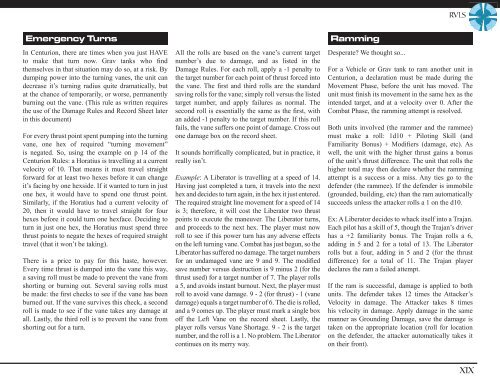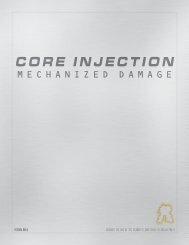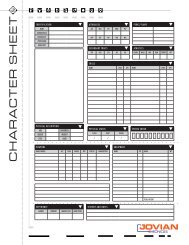renegadelegionneveren dingoffensive - Catsden.net
renegadelegionneveren dingoffensive - Catsden.net
renegadelegionneveren dingoffensive - Catsden.net
You also want an ePaper? Increase the reach of your titles
YUMPU automatically turns print PDFs into web optimized ePapers that Google loves.
RVLS<br />
Emergency Turns<br />
In Centurion, there are times when you just HAVE<br />
to make that turn now. Grav tanks who find<br />
themselves in that situation may do so, at a risk. By<br />
dumping power into the turning vanes, the unit can<br />
decrease it’s turning radius quite dramatically, but<br />
at the chance of temporarily, or worse, permanently<br />
burning out the vane. (This rule as written requires<br />
the use of the Damage Rules and Record Sheet later<br />
in this document)<br />
For every thrust point spent pumping into the turning<br />
vane, one hex of required “turning movement”<br />
is negated. So, using the example on p 14 of the<br />
Centurion Rules: a Horatius is travelling at a current<br />
velocity of 10. That means it must travel straight<br />
forward for at least two hexes before it can change<br />
it’s facing by one hexside. If it wanted to turn in just<br />
one hex, it would have to spend one thrust point.<br />
Similarly, if the Horatius had a current velocity of<br />
20, then it would have to travel straight for four<br />
hexes before it could turn one hexface. Deciding to<br />
turn in just one hex, the Horatius must spend three<br />
thrust points to negate the hexes of required straight<br />
travel (that it won’t be taking).<br />
There is a price to pay for this haste, however.<br />
Every time thrust is dumped into the vane this way,<br />
a saving roll must be made to prevent the vane from<br />
shorting or burning out. Several saving rolls must<br />
be made: the first checks to see if the vane has been<br />
burned out. If the vane survives this check, a second<br />
roll is made to see if the vane takes any damage at<br />
all. Lastly, the third roll is to prevent the vane from<br />
shorting out for a turn.<br />
All the rolls are based on the vane’s current target<br />
number’s due to damage, and as listed in the<br />
Damage Rules. For each roll, apply a -1 penalty to<br />
the target number for each point of thrust forced into<br />
the vane. The first and third rolls are the standard<br />
saving rolls for the vane; simply roll versus the listed<br />
target number, and apply failures as normal. The<br />
second roll is essentially the same as the first, with<br />
an added -1 penalty to the target number. If this roll<br />
fails, the vane suffers one point of damage. Cross out<br />
one damage box on the record sheet.<br />
It sounds horrifically complicated, but in practice, it<br />
really isn’t.<br />
Example: A Liberator is travelling at a speed of 14.<br />
Having just completed a turn, it travels into the next<br />
hex and decides to turn again, in the hex it just entered.<br />
The required straight line movement for a speed of 14<br />
is 3; therefore, it will cost the Liberator two thrust<br />
points to execute the maneuver. The Liberator turns,<br />
and proceeds to the next hex. The player must now<br />
roll to see if this power turn has any adverse effects<br />
on the left turning vane. Combat has just begun, so the<br />
Liberator has suffered no damage. The target numbers<br />
for an undamaged vane are 9 and 9. The modified<br />
save number versus destruction is 9 minus 2 (for the<br />
thrust used) for a target number of 7. The player rolls<br />
a 5, and avoids instant burnout. Next, the player must<br />
roll to avoid vane damage. 9 - 2 (for thrust) - 1 (vane<br />
damage) equals a target number of 6. The die is rolled,<br />
and a 9 comes up. The player must mark a single box<br />
off the Left Vane on the record sheet. Lastly, the<br />
player rolls versus Vane Shortage. 9 - 2 is the target<br />
number, and the roll is a 1. No problem. The Liberator<br />
continues on its merry way.<br />
Ramming<br />
Desperate? We thought so...<br />
For a Vehicle or Grav tank to ram another unit in<br />
Centurion, a declaration must be made during the<br />
Movement Phase, before the unit has moved. The<br />
unit must finish its movement in the same hex as the<br />
intended target, and at a velocity over 0. After the<br />
Combat Phase, the ramming attempt is resolved.<br />
Both units involved (the rammer and the rammee)<br />
must make a roll: 1d10 + Piloting Skill (and<br />
Familiarity Bonus) + Modifiers (damage, etc). As<br />
well, the unit with the higher thrust gains a bonus<br />
of the unit’s thrust difference. The unit that rolls the<br />
higher total may then declare whether the ramming<br />
attempt is a success or a miss. Any ties go to the<br />
defender (the rammee). If the defender is immobile<br />
(grounded, building, etc) than the ram automatically<br />
succeeds unless the attacker rolls a 1 on the d10.<br />
Ex: A Liberator decides to whack itself into a Trajan.<br />
Each pilot has a skill of 5, though the Trajan’s driver<br />
has a +2 familiarity bonus. The Trajan rolls a 6,<br />
adding in 5 and 2 for a total of 13. The Liberator<br />
rolls but a four, adding in 5 and 2 (for the thrust<br />
difference) for a total of 11. The Trajan player<br />
declares the ram a failed attempt.<br />
If the ram is successful, damage is applied to both<br />
units. The defender takes 12 times the Attacker’s<br />
Velocity in damage. The Attacker takes 8 times<br />
his velocity in damage. Apply damage in the same<br />
manner as Grounding Damage, save the damage is<br />
taken on the appropriate location (roll for location<br />
on the defender, the attacker automatically takes it<br />
on their front).<br />
XIX





